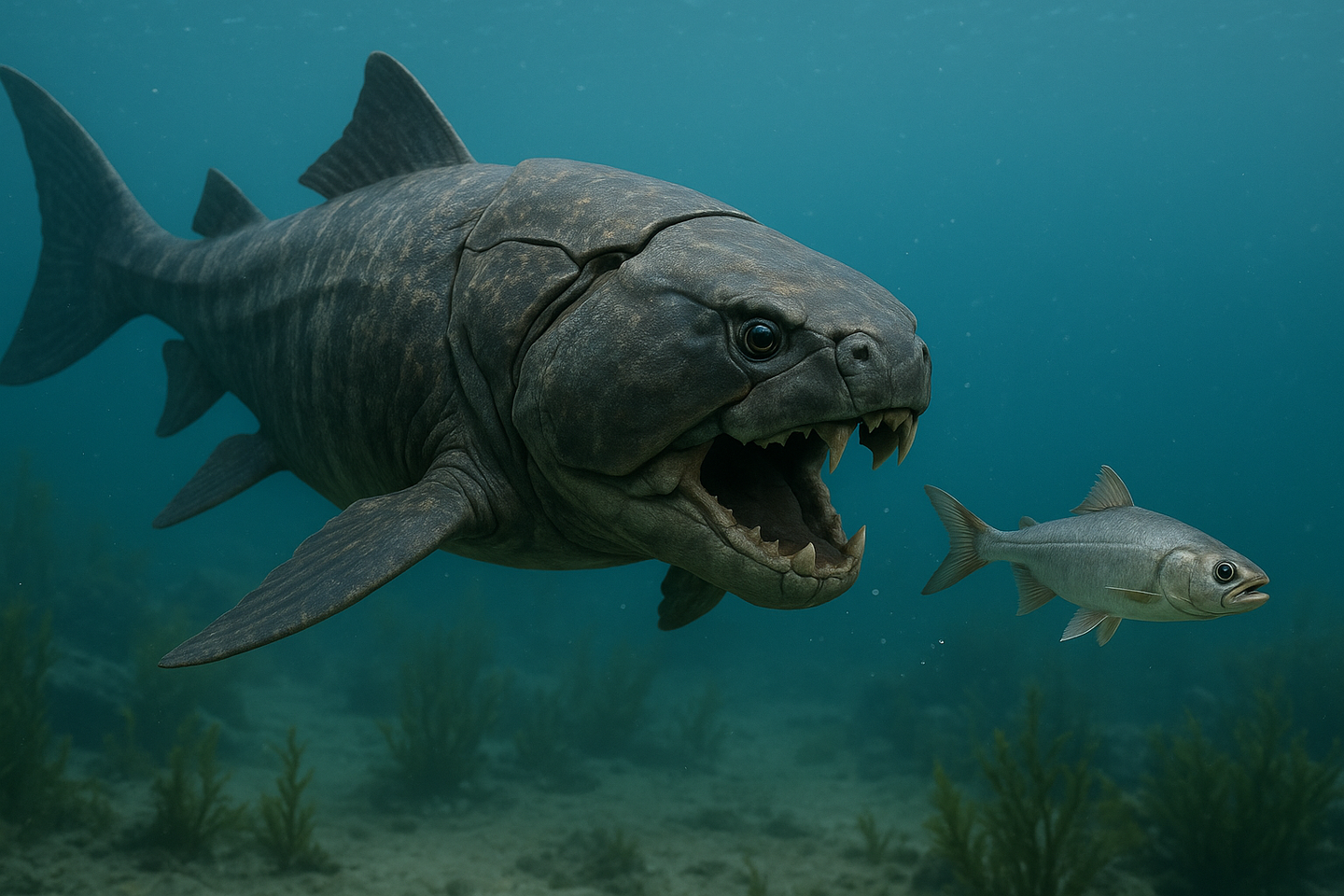360 million-year-old sea predator found to be smaller and much stronger than once thought
A new analysis reveals Dunkleosteus had a cartilage-heavy skull and powerful jaws, reshaping our view of this ancient predator.

 Edited By: Joseph Shavit
Edited By: Joseph Shavit

About 360 million years ago, a huge armored fish patrolled a shallow sea that once covered what is now Cleveland. (CREDIT: AI -generated image / The Brighter Side of News)
About 360 million years ago, a huge armored fish patrolled a shallow sea that once covered what is now Cleveland. This animal, known as Dunkleosteus terrelli, has long held a place among the most fearsome predators in the fossil record. With sharp bone blades instead of teeth and a skull made of heavy armor, it ruled the Late Devonian seas with a presence that still stirs the imagination.
For more than a century, Dunkleosteus has drawn crowds to museums and sparked countless recreations. Its skull hangs in galleries around the world. Yet, for all its fame, scientists have spent almost 90 years without a modern review of its anatomy. That long pause has now ended.
A new international study offers a far more detailed and personal picture of this ancient fish. What the team found reshapes how you think about Dunkleosteus, from its body size to its style of hunting and its place in evolution.
Filling a Century of Scientific Silence
The last major analysis of the Dunkleosteus skull came out in 1932, at a time when researchers had a very limited understanding of arthrodires, the broader group of armored fishes to which it belongs. Many fossils were crushed, incomplete or missing key parts. Because only their bony armor preserved well, almost everything else had to be guessed.
“The last major work examining the jaw anatomy of Dunkleosteus in detail was published in 1932, when arthrodire anatomy was still poorly understood,” said Russell Engelman, a graduate student in biology at Case Western Reserve University and lead author of the study. “Most of the work at that time focused on just figuring out how the bones fit back together.”
Since then, paleontologists have gained a richer view of arthrodires through exceptional fossils from Australia and other regions. Still, no one had returned to the original bones of Dunkleosteus to look for detailed muscle attachments or a clearer sense of how its skull functioned.
This team did exactly that. Supported by collaborators from Russia, the United Kingdom, Australia and Cleveland, they examined the world’s largest collection of Dunkleosteus fossils housed at the Cleveland Museum of Natural History. The rocks around Cleveland proved perfect for preserving these remains, offering a rare window into a creature that once swam across ancient seas worldwide.
Unexpected Anatomy That Changes the Story
The study uncovered several surprising features that challenge the old picture of this predator.
First, nearly half of its skull appears to have been made of cartilage, not bone. This includes many areas where jaw muscles attached. That level of cartilage is far higher than anyone expected and gives Dunkleosteus a lighter, more flexible skull than earlier reconstructions suggested.
Second, the team found strong evidence for a facial muscle similar to one seen in modern sharks and rays. This muscle likely helped the fish close its jaws quickly with powerful force. The researchers spotted this clue in a distinct bony channel that housed the muscle.
Finally, Dunkleosteus turns out to be something of a rule breaker among its arthrodire relatives. Many arthrodires had true teeth, while Dunkleosteus and its closest kin abandoned teeth in favor of their iconic slicing blades. These blades grew sharper as this lineage evolved and likely helped them eat other large, armored fishes.
“These discoveries highlight that arthrodires cannot be thought of as primitive, homogenous animals, but instead a highly diverse group of fishes that flourished and occupied many different ecological roles during their history,” Engelman said.
A Predator Built for Power, Not Suction
Older studies often tried to describe Dunkleosteus as a suction feeder because its jaws opened wide. But the new research points away from that idea. A large mouth reduces suction strength in water, and the bone blades seem designed for cutting, not pulling prey inward.
With the newly recognized shark-like muscle and a skull reinforced by cartilage, the researchers argue that Dunkleosteus bit down hard and fast. It probably carved chunks from prey instead of swallowing whole fish. Its feeding style may have mirrored an ambush predator that struck with force, then ripped through armor or flesh with each jaw snap.
The team also revisited long-standing body size estimates. Earlier studies suggested lengths of 6 to 8 meters. The new measurements point to something different: most adults reached about 3.4 meters, while the largest grew to roughly 4.1 meters. This makes Dunkleosteus still imposing, though not the colossal giant some past reconstructions claimed.
Its trunk armor reveals a deep, heavy body. The torso made up about a quarter of its total length, giving it a thick, muscular shape ideal for strong bursts of motion in open water.
Rewriting the Diversity of Armored Fishes
Perhaps the biggest impact of the study lies in how it reframes arthrodire evolution. Rather than a simple group of armored fishes, arthrodires turn out to be deeply varied animals with different lifestyles, feeding methods and ecological roles. Dunkleosteus represents one specialized branch that took biting to an extreme.
The study emphasizes that the iconic predator was not a perfect representative of all arthrodires. It was an evolutionary outlier with its own set of adaptations for hunting large prey. By placing Dunkleosteus in a more accurate evolutionary context, the research helps scientists better understand how life in Devonian seas responded to rising competition and growing predator diversity.
Practical Implications of the Research
This work gives researchers a fresh, more reliable framework for studying armored fishes and the rise of complex marine ecosystems. By correcting oversimplified views of arthrodire anatomy, the findings help refine evolutionary models and improve reconstructions used in museums, textbooks and scientific work.
The detailed muscle and cartilage insights also support better biomechanical models. These models guide research on how jaws evolve under pressure from changing environments, shifting food webs and new competitors. Understanding the spread of biting strategies helps scientists trace how early vertebrates adapted and how modern jawed fishes eventually emerged.
Beyond paleontology, studies like this offer lessons about resilience and specialization in evolving ecosystems. They highlight how diversity can arise quickly, how species respond to pressure and how apex predators shape the world around them. This deeper view of ancient life strengthens our understanding of biodiversity today and the forces that influence its future.
Research findings are available online in the journal The Anatomical Record.
Related Stories
- Do fish make noise? New technology lets the public hear coral reefs up close
- ‘Cyborg Jellyfish’ could transform ocean research, study finds
- Scientists rethink animal consciousness: Reptiles, fish, and insects may be sentient
Like these kind of feel good stories? Get The Brighter Side of News' newsletter.
Joshua Shavit
Science & Technology Writer and Editor
Joshua Shavit is a Los Angeles-based science and technology writer with a passion for exploring the breakthroughs shaping the future. As a co-founder of The Brighter Side of News, he focuses on positive and transformative advancements in AI, technology, physics, engineering, robotics and space science. Joshua is currently working towards a Bachelor of Science in Business and Industrial Engineering at the University of California, Berkeley. He combines his academic background with a talent for storytelling, making complex scientific discoveries engaging and accessible. His work highlights the innovators behind the ideas, bringing readers closer to the people driving progress.



